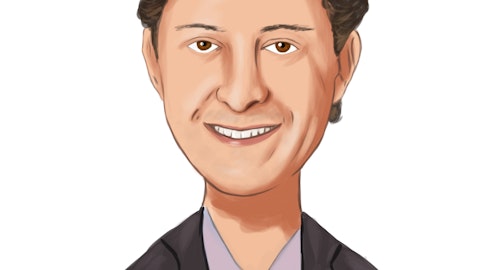Pediatrix Medical Group, Inc. (NYSE:MD) Q4 2022 Earnings Call Transcript February 17, 2023
Operator: Ladies and gentlemen, thank you for standing by, and welcome to the Fourth Quarter 2022 Earnings Conference Call. At this time all participants are in a listen-only mode. Later we will conduct a question-and-answer series. Instructions will be given at that time. And as a reminder, this call is being recorded. I’d now like to turn the call over to our host, Mr. Charles Lynch. Please go ahead, sir.
Charles Lynch: Thank you, operator. Good morning, everyone. I’ll quickly read our forward-looking statements, and then we’ll get into the call. Certain statements and information during this conference call may be deemed to be forward-looking statements within the meaning of the Federal Private Securities Litigation Reform Act of 1995. These forward-looking statements are based on assumptions and assessments made by Pediatrix’ management in light of their experience and assessment of historical risk historical trends, current conditions, expected future developments and other factors they believe to be appropriate. Any forward-looking statements made during this call are made as of today, and Pediatrix undertakes no duty to update or revise any such statements, whether as a result of new information, future events or otherwise.
Important factors that could cause actual results, developments and business decisions to differ materially from forward-looking statements are described in the company’s most recent annual report on Form 10-K, its quarterly reports on Form 10-Q and its current reports on Form 8-K, including the sections entitled Risk Factors. In today’s remarks by management, we will be discussing non-GAAP financial metrics. A reconciliation of these non-GAAP financial measures to the most comparable GAAP measures can be found in this morning’s earnings press release, our quarterly reports on Form 10-Q and our annual report on Form 10-K and on our website at www.pediatrix.com. With that, I’ll turn the call to our Executive Chair, Mark Ordan.
Mark Ordan: Thanks, Charlie, and good morning, everyone. I’m here with Dr. Jim Swift, our Chief Executive Officer; and Marc Richards, our Chief Financial Officer. We announced in December my transition from CEO to Executive Chair; and Dr. Jim Swift’s move from COO to CEO. This has been a naturally smooth transition since we had worked so closely on virtually all issues. It also capped a year-long process to sharply reduce executive leadership and other people-related overhead costs, which has also enabled fully qualified and proven leaders to assume larger roles at Pediatrix. Over the course of 2022, we saw overall stable volumes and payer mix, both of which ended the year on a strong note. We reduced leverage and improved on our sector-leading financial position.
Our revenue cycle transition process, as we have reported, has been very difficult and remains a key operational priority. Within our fourth quarter results, the revenue headwinds caused by our RCM vendors delays in billing activities and extended AR persisted, but were largely offset by negotiated direct financial support provided by the vendor. Marc Richards will detail these offsetting factors in his discussion of the quarter. Since this poor performance persists today, just as in the latter part of 2022, we expect our vendor to provide all necessary support to repair this situation as they knew was necessary in Q4. We believe the plans we discussed on our last call to address the shortfall are the right ones, and Jim will detail where we are today with those plans.
Lastly, we continue to be overwhelmingly in network with constructive dialogue with payers in places where we’re not. We, along with our government relations team and outside advisors continue to work hard to help defend against improper rules applied to what we viewed as a fair and bipartisan No Surprises Act. Now I’ll turn the call over to our Chief Executive Officer, Jim Swift.
Jim Swift: Thanks, Marc, and good morning, everyone. I’m pleased to speak to you today as the CEO of Pediatrix, the company I joined almost 15 years ago. I’ve had the privilege of serving and expanding roles during my tenure here, which has allowed me the honor of working closely with our great position and clinical leaders, our operating team and, of course, our leadership team and Board of Directors. For many of you, I hope I’m also a familiar face and voice having participated in these calls as well as other events over the past several years, touching on our strategy and growth. This morning, I’m pleased to announce that following my appointment, we have named Dr. Curt Pickert, formerly our Chief Physician Executive as Chief Operating Officer, and Lee Wood, formerly our Senior Vice President of National Operations as Executive Vice President of National and Market Operations.

Photo by CDC on Unsplash
I want to congratulate Curt and Lee, both longstanding Pediatrix leaders in their new roles for our operating team. I’ll speak plainly about our outlook for 2023, which reflects the continued burden from our RCM transition activities. Mark Ordan has spoken during the past few years of our view that Pediatrix has fundamental earnings power, which we define as adjusted EBITDA of $250 million and above. We believe that we’re not for the shortfall from the RCM transition we would today be reaffirming this position for 2023. Mark Richards will give additional details underpinning our preliminary 2023 outlook, but at a high level, this outlook contemplates a similar headwind to the adjusted EBITDA that we experienced in 2022, related to our RCM transition activities or roughly $15 million.
The key difference is in 2022, we bore the brunt of that impact in the latter part of the year, while in 2023 it is far heavily weighted in the first half of the year, followed by expected improvements in the second half. Since last fall, we have added meaningful internal RCM staffing, some at a senior corporate level, more at a regional level, and in some instances at practice level. Our primary focus is to ensure full continuity throughout the RCM functions, particularly at the front end where we identify the most prominent root causes of documentation, and billing delays, avoidable non-aisles and other critical steps that have extended our AR cycle. Just as important, we’ve been able to isolate those areas where we’ve identified underperformance in order to validate that they are a deep gaps on the part of our and our vendor’s operations, and not driven by external forces.
To be clear, as of today, our overall RCM performance has not yet improved on a sustained basis. However, we have been able to demonstrate that additional staffing, properly deployed can correct the front end deficiencies we identified. In the areas we first targeted, we’ve seen performance improvement in the form of reduced backlogs, better connectivity through the step functions of the front end processes. Moving from these early positive steps to full sustained improvement at scale is taking time. But we believe we are on the right track and our vendor is committed to the increased operational support required to improve the process. As a result of this work, we are confident that we can enable a highly functional RCM infrastructure. As we and our vendor continue to push our improvement plans, our goal is that this progress translates to our reported results over the coming several quarters.
Turning from our focus on urgent efforts on revenue cycle, I’ll back up and speak at a higher level. I am enthusiastic about the opportunities we have to build on the core fundamental strengths of our organization, which deserves a mention. Demand for the services that our affiliated clinicians provide has been strong. For 2022, our same unit patient volume increased by approximately 2% highlighted by acceleration in the fourth quarter. Same unit burst across the hospitals where we provide services rose moderately for the year, despite a difficult comparison in 2021. We have successfully removed a major layer of executive level overhead as well in other targeted, and important to note, non-clinical areas. We don’t have the crystal ball on the ultimate effects of the No Surprises Act, but we do continue to be overwhelmingly in-network.
And as Mark mentioned, we are in constructive discussions to be back in network in certain instances where we are not in network today. We also continue to look closely at the labor market and possible challenges we may face. But volatility in our cost has been muted compared to other areas of healthcare. We have a strong balance sheet. We repaid substantially all of our borrowings on our revolving credit facility in the fourth quarter, and we began 2023 with a conservative and durable debt structure with low leverage, significant borrowing capacity and extended maturities following last year’s refinancings. We believe our hospital and clinician relationships are strong and combined with this financial strength offer us the opportunities for both organic and inorganic growth.
We are focused directly on these hospital relations and on a very close working relationship with our world-class affiliated clinicians. And most important, our mission, take great care of the patient. It’s a clear one. And the commitment to that mission spans our entire organization, both clinical and non-clinical. As a physician, I know firsthand that this is vital and it informs all of our decision making. Our passion for our patients, clinician, hospital partners, coupled with our adherence to strong and conservative business principles, gives us real confidence in turbulent times. This also provides foundation for care for growth. We are in promising discussions with a number of health systems on ways we can expand what we do. We believe there are opportunities for targeted, acquisitive growth in our core, and we continue to expand and refine our pediatric, primary and urgent care platforms.
As noted in our press release this morning, we believe that our outlook for the coming year represents a realistic achievable near-term financial profile for our company, and it is both my privilege and priority to build on that outlook as we look beyond 2023. To summarize, we have many strengths and many opportunities. We believe that once we can look back on our current RCM challenges, we can have a platform that’s stronger and more efficient than anything we could have done on our own. Working with Curt, Lee and our senior team alongside our affiliated clinicians and support team, I am confident and excited by what’s ahead. With that, I’ll turn the call over to Marc Richards.
Marc Richards: Thanks, Jim. Good morning, everyone. I’ll start with certain components of our fourth quarter results. Our same-unit volumes were strong and payer mix was stable. Within the pricing component of our same unit revenue, we detailed in our press release the impact of the funds received from the CARES program, which were significant in the prior year. Underlying RCM performance presented a similar headwind to what we discussed in Q3, but was largely offset by an advance against older AR provided by our RCM vendor. On the cost side, this incremental Q4 revenue largely flowed through variable comp within practice, salaries and benefits. And our malpractice expense was also elevated, which we view as specific to the quarter and not an ongoing trend.
As a result, adjusted EBITDA was within our expected range for the quarter. Turning to 2023, we expect net revenue of $2 billion to $2.1 billion and G&A expense as a percent of revenue should be comparable to 2022 or just under 12%. Our preliminary outlook for adjusted EBITDA of $235 million to $245 million contemplates a rough $15 million RCM headwind, which, as Jim discussed, is expected to be heavily weighted towards the first half of the year. For reference, we estimate that the headwinds resulting from our RCM transition activities totaled roughly $15 million to $20 million in adjusted EBITDA in 2022. In terms of our quarterly earnings progression, we anticipate that our first quarter adjusted EBITDA will represent 16% to 18% of full year adjusted EBITDA, which is largely due to the normal seasonality of our financial results but also to our outlook for the impact of ongoing RCM transition activities.
Finally, we do not anticipate any additional CARES funds in 2023, which in 2022 contributed $6.7 million in adjusted EBITDA, mostly in the first quarter of last year. Turning finally to our balance sheet. We were paid substantially all remaining revolver borrowings and ended the year with net debt of just under $640 million, leverage of 2.6x. With that, now I will turn the call back over to Jim.
See also 15 Most Valuable Nigerian Companies and 20 Biggest Global Insurance Companies by Market Cap.
Q&A Session
Follow Pediatrix Medical Group Inc. (NYSE:MD)
Follow Pediatrix Medical Group Inc. (NYSE:MD)
Jim Swift: Thank you, Marc. Operator, let’s now open up the call for questions.
Operator: Certainly. Thank you. It looks like we’ll go to Ryan Daniels with William Blair. Please go ahead.
Jack Senft: Hi, guys. This is Jack Senft on for Ryan Daniels. Just wanted to start off and touch on the margin expectations. Just kind of curious how we should be kind of thinking about margins heading into 2023, especially as it relates to the AR reserves. Just given that you kind of expect the headwinds to subside more in the second half, I just kind of wanted to make sure that your expectation or what your expectations are for the second half of this year? And just kind of wanted to see if you’re on track to still kind of see the margins improve in the second half. Thank you.
Marc Richards: Hey, Jack, it’s Marc Richards. Good morning. I would expect margin trends in 2023 to continue very similar to what we saw in 2022, certainly with our expected ramp relative to our RCM transaction activities. We’d expect those to marginally improve towards the second half of the year. But entering into 2023, I’d expect similar margins as we saw in 2022.
Jack Senft: Okay. Awesome. Thank you. Just as a quick follow-up too, just kind of curious how the recovery efforts have trended this quarter and I think it was cumulative $20 million prior to this quarter. Before I know it seems that it was the recovery efforts were tad slower than you originally expected. And that this was an area that you were monitoring and addressing. So just kind of curious how those efforts have progressed and if the success rates have increased. Thanks.
Mark Ordan: Recovery efforts relative to our RCM activity.
Jack Senft: Yes, correct.
Mark Ordan: Yes. I’d say they remained relatively unchanged moving from the third quarter into the fourth quarter in terms of our core RCM activity.
Jack Senft: Okay. Awesome. Thank you. And then just a quick last question here. I’m just kind of curious how labor has trended this quarter and kind of what your expectations are for 2023? Thanks.
Mark Ordan: Yes. We’ve seen labor trends in the quarter with respect specifically to clinical compensation in the 5% range kind of quarter-over-quarter. Jim’s got some more details in terms of
Jim Swift: Yes. And a fair amount of that is related to our contract labor as we brought new programs on organic programs on in the last quarter. So again, we don’t see that necessarily as a trend going forward and we really have not seen material effects of the volatility as I stated.
Jack Senft: Awesome. Thanks, guys.
Operator: And next we can go to AJ Rice with Credit Suisse. Please go ahead.
AJ Rice: Hi everybody. Just because you mentioned a couple times in the prepared remarks, are you seeing any more activity on the part of payers to try to move you out of network and then go to arbitration? Or is it still steady state? I couldn’t really tell from the prepared remarks.
Jim Swift: Yes. AJ, this is Jim. No, it’s steady state. We really not have not seen additional activity or change in behavior by payers where we are in network. And again, as stated, we’re working considerably right now with some of those out of network issues, and we have we feel very strongly that we’re going to be successful, so no material changes.
AJ Rice: Okay. Usually, the last number calls the pediatric urgent care effort has been a topic of discussion and you didn’t really spend any time on that. Any update on what’s happening there?
Jim Swift: Yes. We’re continuing to open up locations in parts of the country in certain geographies, and we have a team of folks working on that inclusive of a new physician that we brought on Board who’s going to be leading our primary care initiatives with those clinics. So the activity continues.





